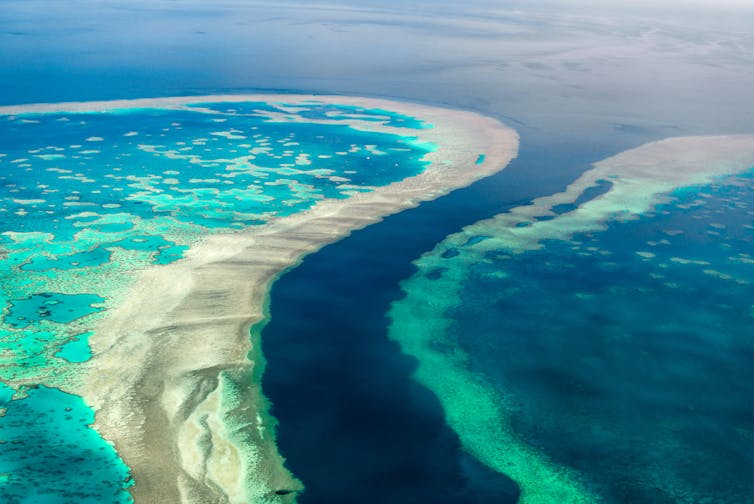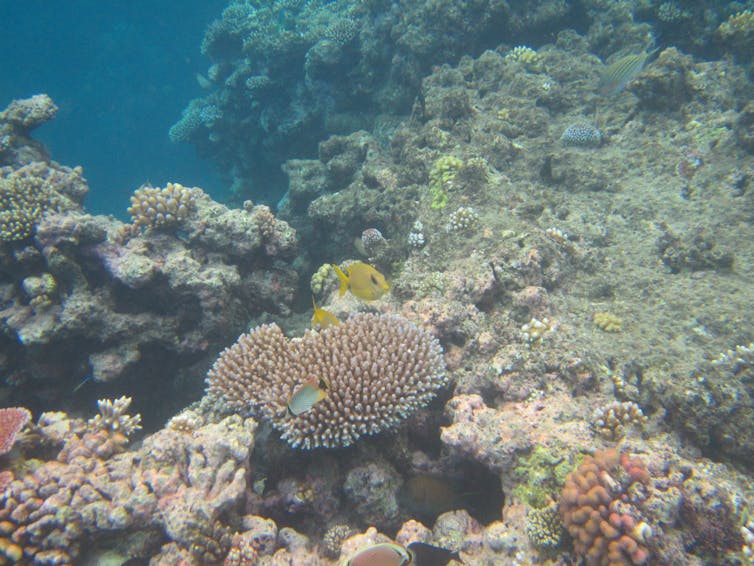Government zoning bias has left marine life in peril since 2012.

Shutterstock
Bob Pressey, James Cook University; Jorge G. Álvarez-Romero, James Cook University; Rodolphe Devillers, Institut de recherche pour le développement (IRD), and Trevor J Ward, University of Technology Sydney
Last week Australia joined a new alliance of 40 countries pledging to protect 30% of the world’s oceans by 2030 from pollution, overfishing, climate change and other environmental threats. Australia already boasts one of the largest networks of marine protected areas in the world, with about half of Commonwealth waters around mainland Australia under some form of protection.
Job done? Actually, no.
Despite the size of our protected areas, marine wildlife continues to vanish. A government report card recently scored the Great Barrier Reef a “D” for its failing health. Meanwhile, commercial fishing depletes non-target or non-economic species as collateral damage, and damages marine habitats through trawling, the marine equivalent of clear felling forests. These issues are extensive, but poorly understood.
So why the paradox? Our research analysis reveals that size is misleading. Marine zonings vary in their effectiveness in protecting biodiversity, and zones established in 2012, 2015 and 2018 put effective protection in the wrong places.
Unhelpful from the start
In a rich, developed country, a society’s commitment to nature conservation is measured by what it’s prepared to give up. In Australia, that’s not much.
In late 2012, Labor announced a massive increase in Commonwealth marine protected areas (MPAs). But it failed to mention that the placement of “highly protected zones” — which don’t allow any commercial extraction — had no effect on oil and gas activities and a very minor effect on commercial fishing.
Many commercial fishing practices, such as trawling, damage marine ecosystems. Shutterstock
As a result, the contribution of the 2012 MPAs to conservation was disproportionately small.
In 2015 the Federal Coalition changed the 2012 zonings. In 2018 the Coalition changed them again.
The Coalition was openly hostile toward the 2012 MPA expansion, so it came as no surprise the 2015 and 2018 MPA systems would become even more strongly residual — biased towards areas with least promise for extractive activities.
Our recent paper tells the story in detail, but here’s a summary.
Zoning the ocean to make almost no difference
Labor’s 2012 additions to the MPA system covered 2.4 million square kilometres, an impressive figure at first glance.
Under the Coalition, the boundaries of Labor’s new MPAs were not altered, but there were large changes to the internal zonings, which specify permitted uses, in 2015 and 2018.
The changes meant highly protected zones declined from 37% of the total MPA system in 2012 to about 22% in 2018. Other zones that allow fishing with varying restrictions, or that place few restrictions on commercial extraction, made up the rest. The conservation benefits of those other zones — dubbed “partially protected areas” — are dubious.
Last week a reef quality report card highlighted the marine environment around the Great Barrier Reef remains poor. Shutterstock
How much difference did all the zoning and rezoning make to marine conservation? Very little.
That’s because, from the start, highly protected zones were put in places with no petroleum extraction and low previous fishing yield. The bias was only exaggerated in 2015, and again in 2018.
By 2018, less than 1% of the area previously used for Commonwealth pelagic longlining had been protected from longlining. Pelagic longlining involves setting baited hooks on lines that can be kilometres long, suspended in the water. It can seriously harm non-target species, including sharks and seabirds.
Likewise, only about 1.5% of Australia’s previously trawled areas became covered by zones that prohibit trawling, a practice also known to have serious biodiversity impacts, such as destroying seafloor habitat.
The zoning of the Coral Sea tells part of the story. The 2012 highly protected zones carefully avoided most commercial fishing in this vast region of open ocean, and research showed the benefits to conservation were “minimal”. When the 2012 zones were changed, the area open to fishing methods that pose ecological risks increased further.
Is Australia really leading the world?
After the latest weakening — proposed in 2017 and formalised in 2018 — of the already weak 2012 marine protection, the federal environment minister and the director of Parks Australia said the revisions achieved the right balance between conservation and use.
In terms of commercial fishing, we show the “balance” was about 2% conservation and 98% use across all of Commonwealth marine waters, which cover almost six million square kilometres.
In real terms, Australia’s marine protection is minuscule, and its marine unprotected areas are vast — a failure that has attracted international criticism. In 2017, for instance, 1,286 researchers from 45 countries lambasted the federal government’s draft marine park management plans that are now in place.
The current highly protected zones might guard against future expansion of petroleum extraction and commercial fishing, as technologies and markets evolve. Unfortunately, however, the chances of that seem slim.
Australian MPA decisions since 2012 suggest strongly that, if highly protected zones are found to prevent profitable extraction, they will be downgraded or moved so they don’t get in the way.
Three ways Australia could lead the world (again)
Australia led the world with the 2004 rezoning of the Great Barrier Reef Marine Park, a systematic exercise that placed about a third of the Park in highly protected zones. But almost 17 years on, we can see plenty of room for improvement in marine conservation as we learn what works and what doesn’t.
How could Australia lead the world now? A first step would be to drop the deception that square kilometres say anything meaningful about conservation.
Our commitment to marine conservation will be measured by how much oil and gas we leave under the seabed, how many fish we leave in the water, and how we catch the others. Decarbonising and properly managing catchments and coastal zones will also be critical.
A second step would be to establish explicit, quantitative, scientifically informed goals for conservation of individual species and ecosystems in highly protected zones. The lack of such goals allowed zonings from 2012 to 2018 to be passed off as representative of marine environments, when they were not.
A third step would be to achieve explicit conservation goals through consultation with diverse stakeholders. This includes co-design and co-management of coastal MPAs that empower local communities and Indigenous peoples from the outset, rather than through consultation late in the process.
After many years of debate over MPAs, some will throw their hands up at the prospect of yet more planning. But that’s what’s needed to make Australia’s MPA zoning effective, along with the (recently elusive) vision and commitment needed for political leadership in real marine conservation.![]()
Bob Pressey, Professor, Conservation Planning, ARC Centre of Excellence for Coral Reef Studies, James Cook University; Jorge G. Álvarez-Romero, Senior Research Fellow, James Cook University; Rodolphe Devillers, Senior research scientist, Institut de recherche pour le développement (IRD), and Trevor J Ward, Visiting Fellow, University of Technology Sydney
This article is republished from The Conversation under a Creative Commons license. Read the original article.



